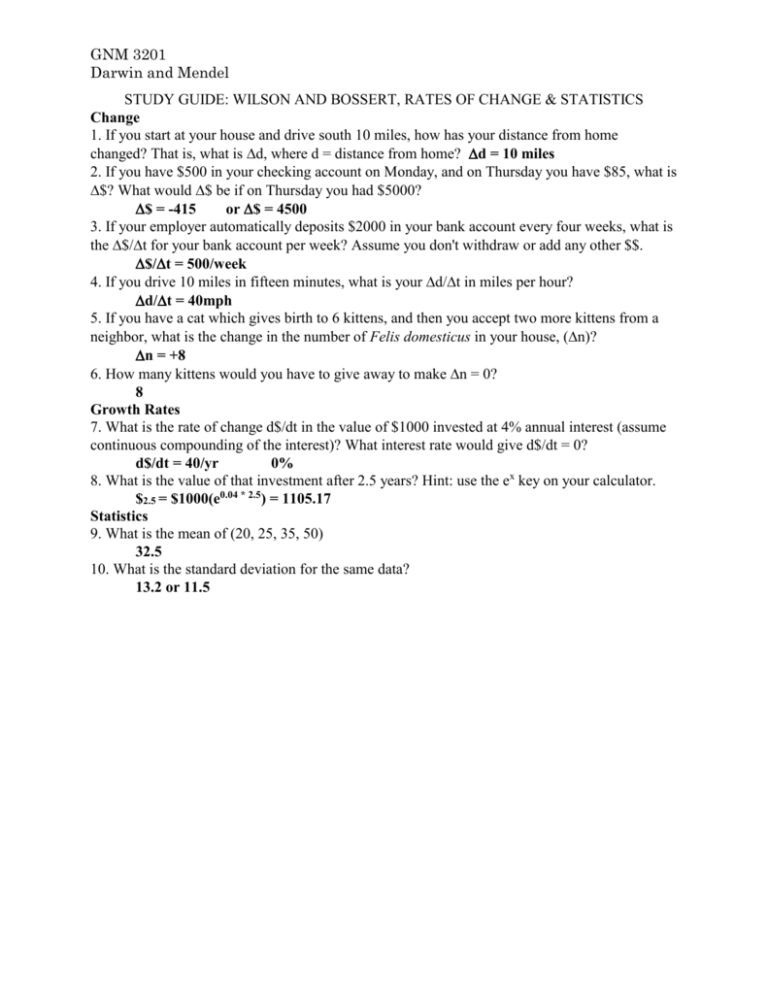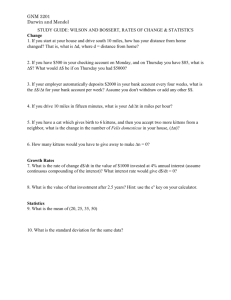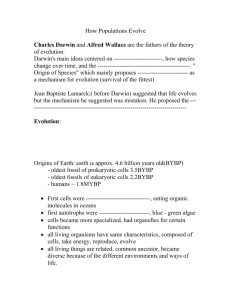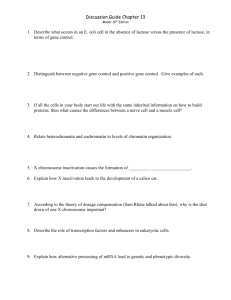answer
advertisement

GNM 3201 Darwin and Mendel STUDY GUIDE: WILSON AND BOSSERT, RATES OF CHANGE & STATISTICS Change 1. If you start at your house and drive south 10 miles, how has your distance from home changed? That is, what is d, where d = distance from home? d = 10 miles 2. If you have $500 in your checking account on Monday, and on Thursday you have $85, what is $? What would $ be if on Thursday you had $5000? $ = -415 or $ = 4500 3. If your employer automatically deposits $2000 in your bank account every four weeks, what is the $/t for your bank account per week? Assume you don't withdraw or add any other $$. $/t = 500/week 4. If you drive 10 miles in fifteen minutes, what is your d/t in miles per hour? d/t = 40mph 5. If you have a cat which gives birth to 6 kittens, and then you accept two more kittens from a neighbor, what is the change in the number of Felis domesticus in your house, (n)? n = +8 6. How many kittens would you have to give away to make n = 0? 8 Growth Rates 7. What is the rate of change d$/dt in the value of $1000 invested at 4% annual interest (assume continuous compounding of the interest)? What interest rate would give d$/dt = 0? d$/dt = 40/yr 0% 8. What is the value of that investment after 2.5 years? Hint: use the ex key on your calculator. $2.5 = $1000(e0.04 * 2.5) = 1105.17 Statistics 9. What is the mean of (20, 25, 35, 50) 32.5 10. What is the standard deviation for the same data? 13.2 or 11.5 GNM 3201 Darwin and Mendel STUDY GUIDE: WILSON AND BOSSERT, POPULATION GENETICS PROBLEMS My son and I used to play a game that used dice that had different numbers of sides. They included 4, 6, 8, 12 and 20-sided shapes. All were numbered from 1 to the total number of sides. If you roll one die with four sides and one with eight sides, what is the chance of getting a pair of threes? p x q is the probability probability of getting 3 on a 4-sided die = 1/4 probability of getting 3 on an 8-sided die = 1/8 so 1/4 x 1/8 = 1/32 is the chance of a pair of 3’s The wrinkled (a) gene occurs at a frequency of 0.55 in a population. What is the frequency of the round (A) gene, if no other forms are present? ANSWER: Frequency of round = 1 - 0.55 = 0.45 A certain recessive gene (a) occurs at a frequency of 0.05 in the population. What is the frequency of the other, dominant form of the gene (A) and what are the expected frequencies of the diploid genotypes (AA, Aa, aa)? ANSWER: Frequency of A = 1 - 0.1 = 0.95 Frequency of AA = (0.95) x (0.95) = 0.9025 Frequency of aa = 2 x (0.95) x (0.05) = 0.095 Frequency of aa = (0.05) x (0.05) = 0.0025 Consider again the round (A) and wrinkled (a) genes. If the frequency of the melanic gene (M) in a moth population is 0.7, what are the frequencies of the three forms (MM, Mm, mm)? ANSWER: Frequency of M = 0.7 Frequency of m = 1 - 0.7 = 0.3 Frequency of MM = (0.7) x (0.7) = 0.49 Frequency of Mm = 2 x (0.7) x (0.3) = 0.42 Frequency of mm = (0.3) x (0.3) = 0.09 If 36% of the individuals in a moth population exhibit the recessive trait, speckled white coloration, what is the frequency of the gene m, for the trait? ANSWER: GNM 3201 Darwin and Mendel Assuming the population is in Hardy-Weinberg equilibrium, 36% represents q , the square of the frequency of the recessive (a). So: q = square root of 0.36 = 0.6 If we have a population consisting entirely of 40 AA and 60 aa individuals, what are the frequencies of the genes A and a? ANSWER: Frequency of A = 80/200 = 0.4 Frequency of a = 120/200 = 0.6 If we had 150 MM individuals in a population and 50 mm individuals, and if they mated at random, what would be the frequencies of MM, Mm and mm individuals in the offspring? ANSWER: Frequency of M = 300/400 = 0.75 Frequency of m = 100/400 =0.25 Frequency of the genotypes: MM = 0.75 x 0.75 = .5625 Mm = 2 x 0.75 x 0.25 = 0.375 Mm = 0.25 x 0.25 = 0.0625 Mutational equilibrium (page 44). What is the equilibrium frequency of gene a2 if the mutation rate () from a1 to a2 is 5 x 10-5 and the mutation rate () from a2 to a1 is 5 x 10-6? The equilibrium frequency is the ratio of the mutation rate from a1 to a2 (5 x 10-5) divided by the sum of the two mutation rates. This is .00005/(.00005+.000005) = 0.91 Gene flow (see pages 46-47): What is the amount of change in a generation of the frequency (q) of an allele where the frequency in one population (q) is 0.3 and in another population (q) is 0.8, if population gets 0.1 of its individuals in each generation from population q -m(q – q) = -0.1(0.3-0.8) = -0.1(-0.5) = 0.05 Selection in one generation (page 50): Calculate the selection coefficients for the following case. Is selection happening? What type? Yes, disruptive selection is happening (against heterozygotes) Genotypes AA Aa aa Number before selection 2300 1000 1700 After selection in same generation Survival Rate Relative Fitness Selection Coefficient 1700 0.74 1.00 0.00 300 0.30 0.41 0.59 1000 0.59 0.80 0.20 GNM 3201 Darwin and Mendel Selection between one generation and the next generation (page 52): Calculate the selection coefficients for the following case. Is selection happening? What type? Genotypes Number in first generation (before selection) Number expected in next generation based on the H-W formula Number in second generation (after selection) Corrected Rate of Increase Relative fitness Selection coefficient AA Aa aa Total gene frequencies of A and a in Gen. 1 4000 3000 3000 10000 9000/20000 = 0.55 0.55 x 0.55 x 10000 = 3025 2 x 0.55 x 0.45 x 10000 = 4950 0.45 x 0.45 x 10000 = 2025 10000 4400 2600 3000 10000 1.45 0.53 1.48 0.98 0.35 1.00 0.02 0.65 0.00 6000/20000 = 0.45 Yes, disruptive selection is happening (the selection is against heterozygotes). Elimination of recessives (page 53): Consider a recessive gene that is lethal when homozygous, but harmless if the dominant gene is present. Suppose we start out with the frequency of that gene in a population equal to 0.3. What will the frequency be after 10 generations if only natural selection affects it? The selection coefficient is 1 against the recessive homozygote, so we can apply the formula on page 53 [6] to get frequency after ten generations = 0.3/(1+10(0.3)) = 0.3/4 = 0.075 Mutation and selection (page 61): Consider a recessive gene that is lethal when homozygous, but harmless if the dominant gene is present. If the mutation rate from the dominant to the recessive is 0.0005, what will be the equilibrium frequency of the recessive allele, if no other factors act on the gene frequencies? Since the selection coefficient is 1, the equilibrium frequency is the square root of 0.0005/1 = square root of 0.0005 = 0.022 GNM 3201 Darwin and Mendel





![Biology Chapter 3 Study Guide Heredity [12/10/2015]](http://s3.studylib.net/store/data/006638861_1-0d9e410b8030ad1b7ef4ddd4e479e8f1-300x300.png)


